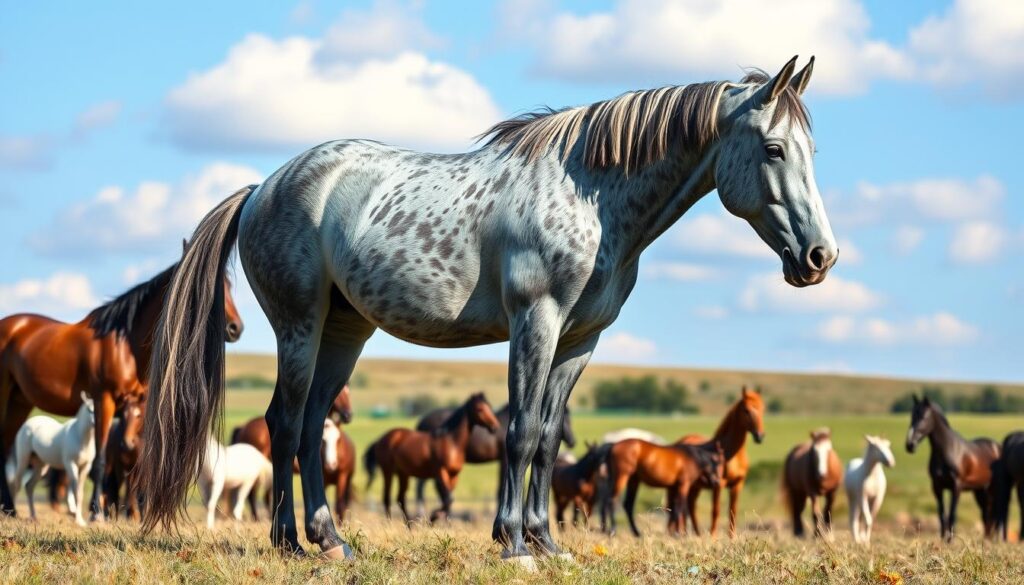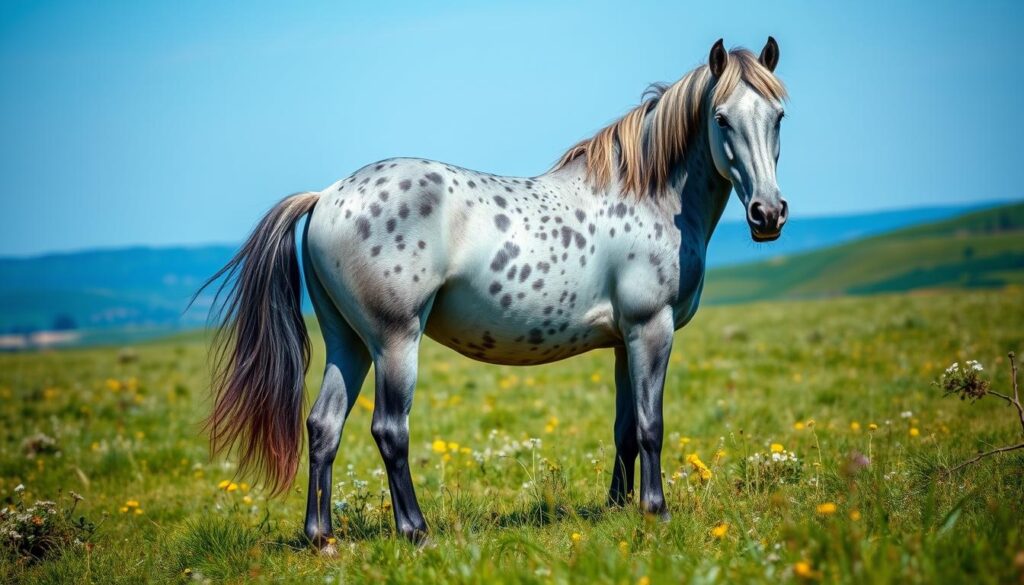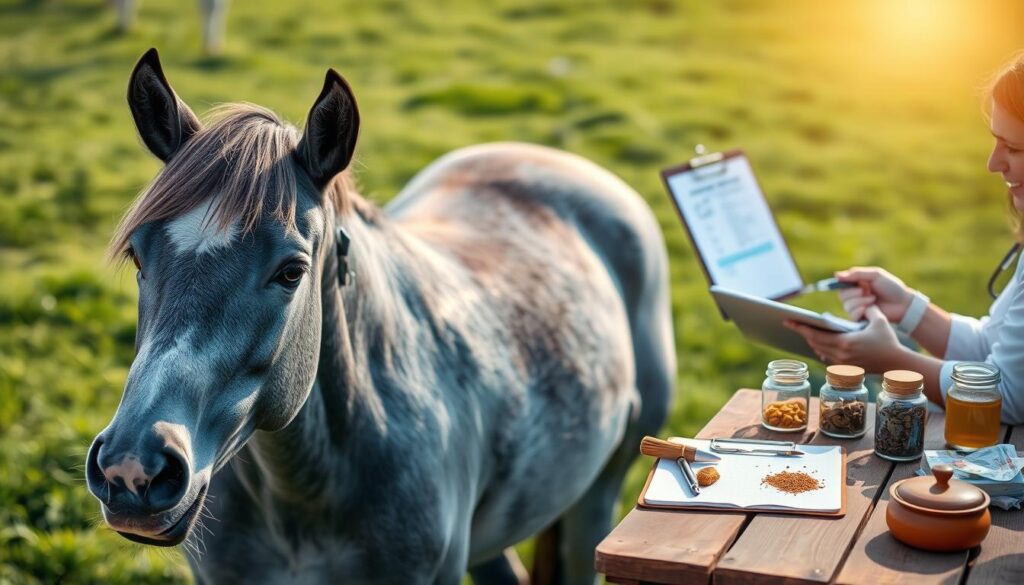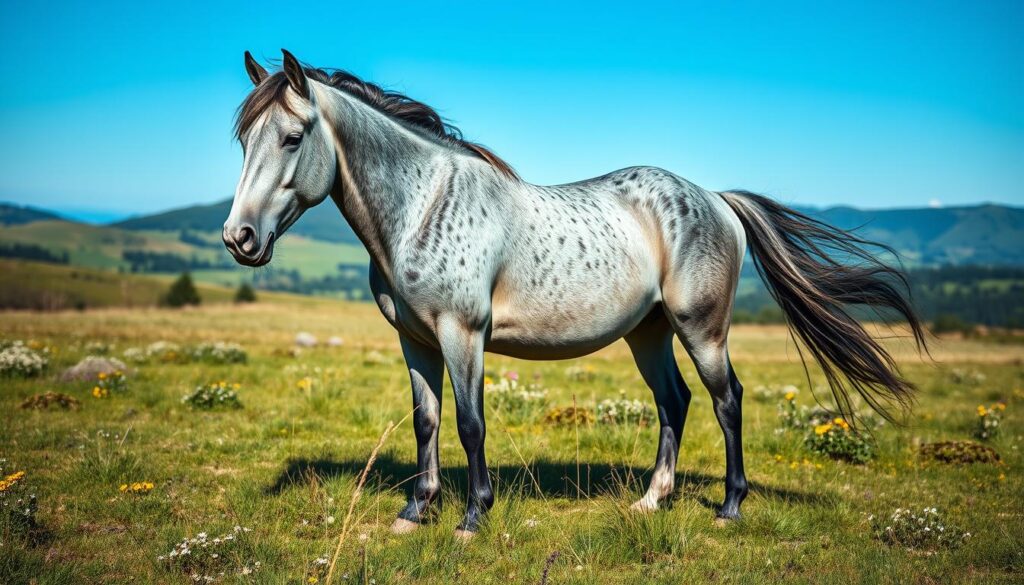Table of Contents
- Understanding the Blue Roan Horse Color Genetics
- Popular Horse Breeds That Carry the Blue Roan Gene
- Distinctive Features of Blue Roan Horses
- Essential Care Requirements for Blue Roan Horses
- Blue Roan Horse Training and Temperament
- Grooming and Maintenance Tips for Blue Roan Coats
- Health Considerations Specific to Blue Roan Horses
- The Historical Significance of Blue Roan Horses
- Choosing and Purchasing a Blue Roan Horse
- Blue Roan Horse Competition and Show Prospects
- Living Environment and Shelter Requirements
- Seasonal Care and Weather Considerations
- Conclusion
- FAQ
Did you know only 1 in every 250 horses has the rare blue roan color? This amazing genetic trait makes their coat truly mesmerizing. It’s a sight that draws in horse lovers from all over.
The blue roan horse’s coat isn’t actually blue. It’s a mix of black and white hair that looks silver-blue. This unique color comes from a special genetic trait, making them stand out from other horses.
Blue roan horses are not just beautiful; they also show the amazing diversity of horses. We’ll dive into seven amazing facts about them. You’ll see why they’re so loved by horse fans and breeders.
Key Takeaways
- Blue roan horses represent a rare genetic color variation
- The coat color results from a unique hair pigmentation pattern
- Multiple horse breeds can produce blue roan coloration
- Genetic inheritance plays a crucial role in blue roan expression
- These horses are prized for their distinctive aesthetic
Understanding the Blue Roan Horse Color Genetics
Blue roan horse genetics are a world of color inheritance that fascinates many. The unique blue roan horse characteristics come from a complex genetic process. This process creates their distinctive coat coloration.

The blue roan horse color comes from a specific genetic mix. This mix creates an even blend of black and white hair on the horse’s body. This color looks bluish-gray because of the hair’s pigmentation.
The Science of Coat Coloration
Blue roan horse genetics involve a special gene for their unique look. The main genetic factors are:
- Presence of the roan gene (Rn)
- Base coat color interactions
- Specific genetic mutations
Inheritance Patterns Explained
To understand blue roan horse characteristics, you need to know about genetic inheritance. The roan gene follows certain patterns:
- One parent must carry the roan gene
- Genetic probability varies with breeding
- Not all offspring will display roan coloration
| Genetic Factor | Inheritance Probability |
|---|---|
| Roan Gene Presence | 50% chance of inheritance |
| Base Coat Influence | Determines final color expression |
| Genetic Variation | Unique to each horse |
Color Variations and Changes
Blue roan horses experience fascinating coat transformations throughout their lives. Their color can change slightly with the seasons, age, and environment. Young blue roans might show more complex color patterns as they grow older.
“Each blue roan horse is a genetic masterpiece, with a coat that tells a unique story of inheritance and variation.” – Equine Genetics Research Institute
Popular Horse Breeds That Carry the Blue Roan Gene
Blue roan horse breeds are loved for their beautiful silver-blue coats. Some breeds are more likely to have this color. This makes them very popular among horse lovers and breeders in the United States.
The most famous blue roan horse breeds are several iconic American types:
- Quarter Horses
- Paint Horses
- Appaloosas
- Kentucky Mountain Saddle Horses
- Tennessee Walking Horses
Each of these breeds has genes that increase the chance of blue roan color. The Quarter Horse is especially known for its stunning blue roan horses.
| Breed | Blue Roan Frequency | Origin |
|---|---|---|
| Quarter Horse | High | United States |
| Paint Horse | Moderate | United States |
| Appaloosa | Moderate | North America |
| Kentucky Mountain Saddle Horse | Low | Kentucky, USA |
“The blue roan color is not just a coat, but a genetic masterpiece that tells a unique story of inheritance and beauty.”
International breeds like the Ardennes from Belgium and the Welsh Pony also have blue roan horses. This adds to the color’s genetic diversity.
Distinctive Features of Blue Roan Horses
Blue roan horses are a sight to behold. Their coat pattern is unique, blending white and colored hairs. This creates a “blue” look that makes them stand out.

Physical Characteristics That Define Blue Roans
Blue roan horses have a special coat pattern. It’s a mix of colored and white hairs that looks silver-blue. This color is most seen on their body, neck, and hindquarters.
- Body trunk and shoulders
- Neck and chest areas
- Hindquarters
Unique Color Distribution Patterns
Every blue roan horse is different. The way white and colored hairs mix up creates a unique look. This makes each horse special.
| Color Characteristic | Description |
|---|---|
| Base Color Mix | 50% white, 50% base color hairs |
| Typical Base Colors | Black, bay, or chestnut |
| Color Intensity | Varies with genetics and age |
Common Misconceptions About Blue Roans
Many think blue roan horses are actually blue. But, their coat is a mix of white and dark hairs. This creates a blue-like look.
“The beauty of a blue roan horse lies in its complex, intricate coat pattern that seems to shimmer and change with movement.” – Equine Color Genetics Expert
Age-Related Color Changes
As blue roan horses get older, their coat changes. Young ones have a bold roan pattern. This pattern softens as they grow up. Sunlight, diet, and genetics affect their coat’s look.
Essential Care Requirements for Blue Roan Horses
Blue roan horse care needs special attention to keep their coat looking great. These horses need a detailed care plan for nutrition, grooming, and daily upkeep. This is more than just basic horse care.

Starting with the right diet is key for blue roan horse care. Their unique coat color benefits from a balanced diet. This diet supports their coat health and overall well-being.
- High-quality hay and pasture grass
- Balanced mineral supplements
- Consistent fresh water supply
- Protein-rich feed for coat maintenance
Nutrition is vital for the vibrant blue roan coat’s color and shine. Experts suggest a diet full of essential nutrients. These nutrients help keep the coat healthy and the horse full of energy.
| Nutritional Requirement | Daily Recommendation | Benefit for Blue Roan Horses |
|---|---|---|
| Protein | 1.5-2 lbs per 1000 lbs body weight | Coat strength and color maintenance |
| Omega-3 Fatty Acids | 1/4 cup daily | Coat shine and skin health |
| Zinc and Biotin | Supplement as recommended | Hair growth and coat quality |
“The key to exceptional blue roan horse care is understanding their unique nutritional and grooming requirements.” – Equine Nutrition Specialist
Regular grooming is crucial for blue roan horses. Their coat needs special care to keep its color and prevent skin problems. Brush your horse every day with soft brushes. This removes dirt and spreads natural oils.
- Daily brushing with specialized brushes
- Monthly deep coat conditioning
- Regular health check-ups
- Seasonal coat protection
By using these special care methods, owners can keep their horses healthy and vibrant. This ensures their stunning blue roan color shines brightly.
Blue Roan Horse Training and Temperament
Blue roan horses are known for their unique coat and personality. Understanding their temperament is key for successful training and bonding.
These horses are intelligent and sensitive. Their balanced nature makes them great companions for experienced riders and trainers.
Behavioral Traits and Personality
The blue roan horse temperament includes several key traits:
- High intelligence and quick learning ability
- Strong desire to please their handlers
- Moderate energy levels
- Natural curiosity about their environment
“A blue roan horse’s temperament is like a finely tuned instrument – responsive, nuanced, and capable of remarkable connection.” – Equine Behavior Expert
Training Tips and Best Practices
Here are some training strategies for blue roan horses:
- Use positive reinforcement techniques
- Maintain consistent and patient training sessions
- Respect their sensitive nature
- Provide mental stimulation alongside physical training
Building Trust with Your Blue Roan
To build a strong bond with a blue roan horse, understand their unique temperament. Spend quality time together, use gentle communication, and create a supportive training environment.
Remember, while blue roan horses have general temperament traits, each horse is an individual with its own personality and learning style.
Grooming and Maintenance Tips for Blue Roan Coats

Blue roan horses need special care to keep their coat looking its best. They require a grooming routine that’s more than just basic horse care.
To care for a blue roan horse, you must understand its coat’s unique color. Regular grooming helps keep the blue tint and keeps the horse’s skin healthy.
- Daily Brushing: Use soft-bristled brushes to remove dirt and distribute natural oils
- Color-Specific Tools: Select brushes that won’t damage the fine blue roan coat texture
- Gentle metal combs for detangling mane and tail
- Microfiber towels for coat shine
“A well-groomed blue roan horse reflects the dedication of its caretaker” – Equine Grooming Experts
Seasonal changes affect blue roan horse care a lot. In summer, they need more baths. In winter, they need special grooming to keep their coat healthy.
Using grooming products made for unique coat colors can make the blue roan’s shine brighter. Look for shampoos and conditioners that keep the coat’s color safe.
- Use color-preserving equine shampoos
- Avoid harsh chemical treatments
- Implement regular coat conditioning
By spending time on proper grooming, horse owners can keep their blue roan looking great and healthy all year.
Health Considerations Specific to Blue Roan Horses
Blue roan horses need special care to stay healthy and live longer. Knowing their health needs helps owners give the best care. This can prevent health problems.

Genetic Health Predispositions
Blue roan horses might have genetic health issues. These can affect their health and how long they live.
- Increased risk of coat-related skin sensitivities
- Potential hereditary muscular disorders
- Higher susceptibility to specific genetic mutations
Essential Preventive Care Strategies
Keeping a blue roan horse healthy is key. Regular vet visits and screenings help find problems early.
- Annual comprehensive health examinations
- Updated vaccination protocols
- Regular dental and hoof care
Nutritional Requirements
Blue roan horses need a special diet. A balanced diet is important for their health and energy.
| Nutritional Component | Recommended Intake | Health Benefits |
|---|---|---|
| Protein | 10-12% of daily diet | Muscle development |
| Minerals | Balanced mineral supplement | Bone strength |
| Omega-3 Fatty Acids | Daily supplementation | Coat health |
*”Prevention is always better than cure in horse healthcare.”* – Equine Veterinary Association
With the right care, blue roan horse owners can help their horses stay healthy. This can even help them live longer with the right care and knowledge.
The Historical Significance of Blue Roan Horses

The blue roan horse has a special place in American history. They were important to early settlers, ranchers, and Native American tribes in the western United States. These horses were more than just animals; they were companions in the wild.
Blue roan horses were important in many ways:
- Native American horse breeding traditions
- Western frontier transportation and exploration
- Ranching and cattle management
- Military cavalry units
“In the vast plains of the American West, blue roan horses represented more than transportation—they were symbols of resilience and partnership.” – Western Horse Historians Association
In the 19th century, blue roan horses were key to ranching. Their color and strength made them valuable to cowboys and settlers. Native American tribes also cherished them for their ability to thrive in different environments.
The history of blue roan horses is a story of cultural exchange and survival. These horses were essential in human migration, exploration, and settlement in North America.
Horse breeds like the Quarter Horse and Mustang often had blue roan coloration. This made them even more important in American equine history.
Choosing and Purchasing a Blue Roan Horse
Buying a blue roan horse is a big deal for horse lovers. It’s important to know the market and what to look for. This way, you can choose the right horse for you.

When looking at blue roan horse prices, there are many things to think about. The horse’s breed, age, training, and health all affect the price.
Key Considerations Before Purchasing
- Evaluate the horse’s genetic lineage
- Assess physical conformation and health history
- Understand training background
- Verify veterinary documentation
Blue Roan Horse Price Range
| Horse Category | Price Range | Typical Characteristics |
|---|---|---|
| Beginner/Companion | $3,000 – $7,500 | Minimal training, younger horses |
| Intermediate Riding | $7,500 – $15,000 | Consistent training, proven temperament |
| Performance/Show Quality | $15,000 – $50,000 | Professional training, competition experience |
Prices for blue roan horses change based on their breed. Quarter Horses and Rocky Mountain Horses are often sought after. They come at different prices.
“Investing in a blue roan horse means selecting not just a horse, but a unique genetic masterpiece.” – Equine Experts Association
Market Insights for Blue Roan Horse Buyers
Future owners should look into local markets and horse auctions. Talking to experts in specific breeds can help. Joining horse communities can also lead you to the right blue roan horse at a good price.
Blue Roan Horse Competition and Show Prospects
Blue roan horses are stars in the equestrian world. Their unique coat color and special traits make them stand out in shows. They excel in many areas, catching the eye of judges and fans.

Judges love blue roan horses for their movement and looks. Their coat color grabs attention right away.
“A blue roan horse doesn’t just compete – they command the arena’s attention,” says professional equestrian trainer Sarah Martinez.
Preparing blue roan horses for shows involves:
- Emphasizing their natural coat color
- Keeping their grooming perfect
- Showing off their training skills
- Highlighting their unique strengths
| Competition Category | Blue Roan Performance Rating | Typical Strengths |
|---|---|---|
| Western Pleasure | Excellent | Smooth gaits, calm demeanor |
| Reining | Very Good | Agility, quick responsiveness |
| Ranch Riding | Outstanding | Versatility, working horse traits |
Blue roan horses continue to captivate the equestrian community with their remarkable show ring presence and exceptional performance capabilities.
Living Environment and Shelter Requirements
Creating the perfect living environment is key for blue roan horse care. Each horse needs a shelter that protects their coat and supports their health. The right shelter varies by region in the United States.
Essential shelter elements for blue roan horses include:
- Sturdy, well-ventilated stable structures
- Protection from extreme weather conditions
- Adequate space for movement
- Clean, dry bedding
The ideal shelter should provide:
- Minimum of 12×12 feet per horse stall
- Overhead protection from sun and rain
- Natural windbreaks in open pastures
- Proper drainage to prevent moisture buildup
“A horse’s shelter is more than just a roof—it’s their sanctuary and protection from environmental challenges.” – Equine Housing Expert
Climate is crucial in blue roan horse care. In hot places like Texas, horses need shade and air. In cold areas like Montana, they need strong shelters against winter.
Proper care means knowing each horse’s needs and adapting their home. Regular upkeep, cleaning, and design create a safe, comfy space for these lovely animals.
Seasonal Care and Weather Considerations
Blue roan horse care needs special attention to the seasons. Each season brings its own challenges. These require specific care to keep these beautiful horses healthy and happy.
Winter care for blue roan horses is crucial. They need extra protection from the cold:
- Provide thick, waterproof blankets for temperature regulation
- Ensure access to wind-protected shelters
- Increase hay intake for additional calorie generation
- Check water sources to prevent freezing
In summer, blue roan horse care is different. Their unique coat color can make them hotter. So, sun protection is key.
| Season | Key Care Considerations | Recommended Actions |
|---|---|---|
| Summer | Heat Management | Provide shade, electrolyte supplements, frequent water access |
| Winter | Cold Protection | Warm blankets, increased feed, windbreak shelters |
| Spring/Fall | Transitional Care | Monitor coat changes, adjust nutrition, watch for allergies |
“Proper seasonal adaptation is the key to maintaining a healthy and happy blue roan horse.” – Equine Care Experts
Spring and fall need careful attention for blue roan horses. Watch for coat shedding and adjust their diet. Also, keep an eye out for allergies. Regular vet visits during these times help avoid health problems.
Conclusion
Blue roan horse facts show us a world of beauty and genetic complexity. These horses are more than their unique coat color. They represent a mix of breed diversity, genetic inheritance, and adaptability.
Their silvery-blue look and genetic makeup are fascinating. Blue roan horses capture the hearts of many in the United States.
To truly appreciate blue roan horses, we must understand their physical traits, care needs, and history. Their color comes from a complex genetic process. This creates a mesmerizing mix of black and white hair, giving them that blue-tinted coat.
Each blue roan horse has its own story of genetic inheritance and beauty. They are truly unique.
Blue roan horses are a great way for horse lovers to learn about equine genetics and color variation. They are versatile, fitting into many breeds, disciplines, and living situations. They make amazing companions for those who are willing to learn about their needs.
Reflecting on blue roan horses, we see they are more than their coat color. They are a blend of science, history, and natural wonder. They invite us to explore their world and appreciate the diversity of equine genetics.
FAQ
What exactly is a blue roan horse?
A blue roan horse has a special coat color. It’s a mix of white and dark hairs, giving it a blue-gray look. This color comes from a genetic pattern that spreads white and colored hairs evenly over the body.
How do blue roan horses get their color?
Blue roan horses get their color from a specific gene. This gene mixes white hairs with the base coat color. You can find this gene in breeds like Quarter Horses, Mustangs, and Paint Horses.
Are blue roan horses rare?
Blue roan horses are not super rare but less common than other colors. They’re special and loved by many horse fans. The rarity can change based on the breed.
Do blue roan horses change color with age?
Yes, blue roan horses’ color can change over time. Their coat might look different in winter and summer. As they get older, the blue roan color might change too.
What special care do blue roan horses require?
Blue roan horses need regular care like any other horse. But, their coat needs special attention. They need grooming to keep their look, sun protection, and extra care during coat changes.
Which horse breeds are most likely to have blue roan coloration?
Many breeds can have blue roans, like Quarter Horses, Paint Horses, and Mustangs. Welsh Ponies and Friesian crosses can also have this color. Western breeds are especially known for blue roans.
Are there any health concerns specific to blue roan horses?
Blue roan horses don’t have special health issues. But, they need regular vet visits, good food, and care. Their color doesn’t mean they have any health problems.
How much does a blue roan horse typically cost?
The cost of a blue roan horse varies a lot. It depends on the breed, age, training, and quality. Prices can be from $3,000 to $15,000 or more. High-quality or rare horses can cost even more.
Can blue roan horses be used for different equestrian disciplines?
Yes, blue roan horses are very versatile. They can do Western riding, ranch work, trail riding, dressage, and shows. Their abilities depend on the horse and breed, not just their color.
